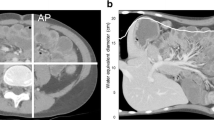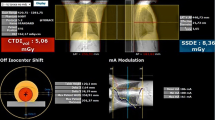Abstract
Background
A child’s body size is not accurately reflected by volume CT dose index (CTDIvol) and dose–length product (DLP). Size-specific dose estimation (SSDE) was introduced recently as a new index of radiation dose. However, it has not yet been established as a diagnostic reference level (DRL).
Objective
To calculate the SSDE of abdominal/pelvic CT and compare the SSDE with CTDIvol. To calculate the DRLs of CTDIvol and SSDE. Our hypotheses are: SSDE values will be greater than CTDIvol, and our DRL will be smaller than the known DRLs of other countries.
Materials and methods
The CTDIvol and DLP of 117 children who underwent abdominal/pelvic CT were collected retrospectively. The SSDE was calculated from the sum of the lateral and anteroposterior diameters. The relationships between body weight and effective diameter and between effective diameter and CTDIvol/SSDE were compared. Further, the local DRL was compared with the DRLs of other countries.
Results
Body weight and effective diameter and effective diameter and SSDE were positively correlated. In children ages 1, 5 and 10 years, the SSDE is closer to the exposure dose of CTDIvol for the 16-cm phantom, while in children ages 15 years, the SSDE falls between CTDIvol for the 16-cm phantom and that for the 32-cm phantom. The local DRL was lower than those of other countries.
Conclusion
With SSDE, the radiation dose increased with increasing body weight. Since SSDE takes body size into account, it proved to be a useful indicator for estimating the exposure dose.





Similar content being viewed by others
References
Sivit JC (2008) Contemporary imaging in abdominal emergencies. Pediatr Radiol 38:S675–678
Pearce MS, Salloti JA, Little MP et al (2012) Radiation exposure from CT scans in childhood and subsequent risk of leukemia and brain tumors: a retrospective study. Lancet 380:499–505
Mathews JD, Forsythe AV, Brady Z et al (2013) Cancer risk in 680000 people exposed to computed tomography scans in childhood or adolescence: data linkage of 11 million Australians. BMJ 346:f2360
International Commission on Radiological Protection (ICRP) (2007) Managing patient dose in multi-detector computed tomography (MDCT). ICRP Publication 102. Ann. ICRP 37. Elsevier, Amsterdam
Galanski M. Nagal HD. Stamm G (2007) Paediatric CT exposure practice in the federal republic of Germany. Results of a nationwide survey in 2005/6. Medizinishe Hochschule Hannover. Available via www.mh-hannover.de/fileadmin/kliniken/diagnostische_radiologie/download/Report_German_Paed-CT-Survey_2005_06.pdf. Accessed 29 Nov 2013
Verdun FR, Gutierrez D, Vader JP et al (2008) CT radiation dose in children: a survey to establish age-based diagnostic reference levels in Switzerland. Eur Radiol 18:1980–1986
Brisse HJ, Aubert B (2009) CT exposure from pediatric MDCT: results from the 2007-2008 SFIPR/ISRN survey. J Radiol 90:207–215
Buls N. Bosmans H. Mommaert C et al (2010) CT paediatric doses in Belgium: a multi-center study: results of a dosimetry audit 2007–2009. Available via http://www.fanc.fgov.be/GED/00000000/2400/2449.pdf, Accessed 29 Nov 2013
Kritsaneepaiboon S, Trinavarat P, Visrutarathna P (2012) Survey of pediatric MDCT radiation dose from university hospitals in Thailand: a preliminary for national dose survey. Acta Radiol 52:820–826
McNitt-Gray M (2011) Assessing radiation dose: how to do it right. AAPM 2011 Summit on CT dose available via http://www.aapm.org/meetings/2011CTS/documents/McNitt-GrayAssessingRadiationdoseFINAL.pdf#search= ’McNittGray + M.Assessing + radiation + dose%3A + how + to + do + it + right’. Accessed 29 Nov 2013
Miyazaki O, Horiuchi T, Masaki H et al (2008) Estimation of adaptive computed tomography dose index based on body weight in pediatric patients. Radiat Med 26:98–103
Boone JM. Strauss KJ. Code DD et al (2011) Size-specific dose estimates (SSDE) in pediatric and adult body CT examinations. AAPM Report No. 204. Available via http://www.aapm.org. Accessed 14 June 2011
Strauss KJ, Goske MJ (2011) Estimated pediatric radiation dose during CT. Pediatr Radiol 41:S472–S482
International Commission on Radiological Protection (ICRP) (1991) Recommendations of the international commission on radiological protection. ICRP Publication 60. Ann. ICRP 21 (1–3)
International Commission on Radiological Protection (ICRP) (1996) Radiological protection and safety in medicine. ICRP Publication 73. Ann. ICRP 26 (2)
Shrimpton PC, Hiller MC, Lewis MA et al (2006) National survey of doses from CT in the UK: 2003. Br J Radiol 79:968–980
Thomas KE (2011) CT utilization – trends and developments beyond the United States’ borders. Pediatr Radiol 41:S562–566
International Commission on Radiological Protection (ICRP) (2013) Radiological protection in paediatric diagnostic and interventional radiology. ICRP Publication 121. Ann. ICRP 42 (2)
Lindskoug BA (1992) The reference man in diagnostic radiology dosimetry. Br J Radiol 65:S431–437
Lindskoug BA (1992) Exposure parameters in X ray diagnostics of children infants and the newborn. Radiat Prot Dosim 43:S289–292
Tsushima Y, Taketomi-Takahashi A, Takei H et al (2010) Radiation exposure from CT examinations in Japan. BMC Med Imaging 10:24
Slovis TL, Hall ET, Huda W et al (2002) ALARA conference executive summary. Pediatr Radiol 32:221
International Electrotechnical Commission (IEC) (2002) Medical electrical equipment. Part 2–44: particular requirements for the safety of x-ray equipment for computed tomography. IEC publication No. 60601–2–44, edn 2.1. IEC Central Office, Geneva
Acknowledgement
This article was supported by the Grant of National Center for Child Health and Development, Japan, 23 A – 4, 26–20
Conflicts of interest
None
Author information
Authors and Affiliations
Corresponding author
Rights and permissions
About this article
Cite this article
Imai, R., Miyazaki, O., Horiuchi, T. et al. Local diagnostic reference level based on size-specific dose estimates: Assessment of pediatric abdominal/pelvic computed tomography at a Japanese national children’s hospital. Pediatr Radiol 45, 345–353 (2015). https://doi.org/10.1007/s00247-014-3189-4
Received:
Revised:
Accepted:
Published:
Issue Date:
DOI: https://doi.org/10.1007/s00247-014-3189-4




